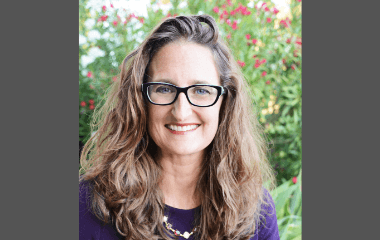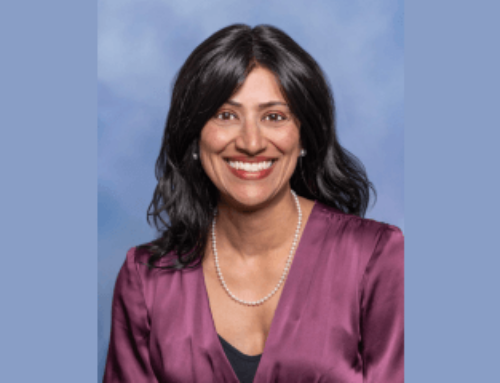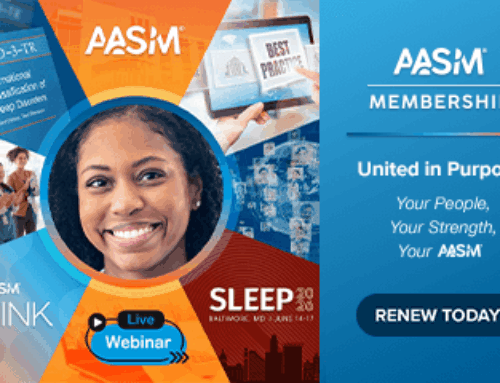Jennifer L. Martin, PhD, completed her term as president of the American Academy of Sleep Medicine board of directors on Monday, June 5, 2023, during the AASM annual membership meeting, which took place in Indianapolis as part of the SLEEP 2023 annual meeting of the Associated Professional Sleep Societies.
This is an excerpt of the remarks that she presented during the membership meeting.
Remarks by Dr. Jennifer Martin
It is my honor to present to you the report of the Academy president.
Last June when I became Academy president, we were more than two years into a global pandemic, and one year into a massive PAP device recall. While sleep medicine professionals were hopeful that better days were on the way, we were also a bit discouraged. It had been two difficult, challenging years for the sleep field. We needed some encouragement. We needed a sign that our hard work and perseverance was making a difference. Less than one month into my presidency, we received such a sign.
On June 29 of last year, the American Heart Association announced that it had replaced its “Life’s Simple 7” checklist with the new “Life’s Essential 8” tool, adding sleep as one of the 8 key measures for improving and maintaining cardiovascular health. That was a great encouragement. For decades, Academy members have been identifying and emphasizing the link between sleep health and heart health. In the Academy’s “Sleep is Essential to Health” position statement published in 2021, we highlighted a study which had found that the Life’s Simple 7 score would be stronger if it included sleep. It was exciting to see our message gaining traction.
The sleep field received another spark of encouragement less than a month ago when Florida followed California by enacting a law requiring later school start times for middle schools and high schools beginning in 2026. Our members have been advocating for such a change for years, and the Academy published a position statement on this issue in 2017. Now we have later school start time laws in California and Florida – on both ends of the country, and both sides of the political aisle. Maybe sleep is an issue that can unite us!
Well, the next test case for the unifying power of sleep is the changing of our external clocks. Through our advocacy and public relations efforts, the Academy has played a leading role in opposing the establishment of permanent daylight saving time and supporting permanent standard time as the healthier alternative. Both legislators and the media have taken notice. As president I spent the better part of the weeks before the time changes engaged with media outlets explaining that standard time better aligns with human circadian rhythms and permanent daylight saving time would compromise health and safety. We received more positive signs last fall when the Sleep Research Society published a position statement on this topic, and the AMA House of Delegates adopted a resolution supporting permanent standard time. To strengthen our efforts, the Academy recently approved the formation of a Standard Time Coalition, which will work closely with the Save Standard Time organization. Partners in this endeavor will include the National Sleep Foundation, the Sleep Research Society, and the Society for Research on Biological Rhythms. Together we can make a difference.
Other advocacy challenges arose throughout the year, and our members have been instrumental in bringing these to our attention. For example, based on member feedback last fall, we addressed concerns about Medicare audits in one region of the country that were not consistent with CMS’s own policies regarding diagnostic testing for OSA. More recently, Academy members expressed concern that Blue Shield of California was inappropriately denying reimbursement for PAP therapy when only one respiratory monitoring belt is used during the diagnostic sleep study. We responded immediately with a clarifying letter to Blue Shield urging them to correct a policy that we found inconsistent with our scoring manual.
Members also brought concerns to us about payer requirements for pediatric PAP therapy. Some payors have age and weight requirements that force younger and smaller children with OSA to receive PAP therapy only from a home ventilator rather than a less-expensive PAP device. We responded by publishing a position statement clarifying that CPAP can be safe and effective in younger children regardless of weight. We depend on all of you – our members – to bring these issues to our attention. For any payor-related concerns, we even have a special email address: coding@aasm.org. Use it. We will respond and support you in providing outstanding care to your patients.
Another issue that the Academy is seeking to address is the lack of reimbursement for psychological and behavioral treatments for insomnia, including CBT-I. I am extremely grateful to this year’s joint presidential committee, with the Society of Behavioral Sleep Medicine, who worked this year to identify challenges and educating payers about clinical practice guidelines supporting CBT-I as an effective treatment for insomnia disorder. Last fall, we also hosted a virtual summit to identify and prioritize strategies to increase access to high-quality care for insomnia disorder including and beyond CBT-I. We’re finalizing a report for publication.
In December, we published our latest clinical practice guideline for the management of REM sleep behavior disorder. It captures new evidence from several clinical trials conducted in the last decade. The guideline provides clinicians with valuable insight on how to prevent sleep-related injury and provide patients with a risk assessment for neurological disease.
In February, the Academy released Version 3 of the Manual for the Scoring of Sleep and Associated Events, which includes both new and updated rules and notes. Most importantly, it changes the 4% scoring rule for hypopneas from ACCEPTABLE to OPTIONAL. The rationale for this decision was explained previously in the Academy’s position statement on arousal-based scoring.
Also hot off the press is the text revision of the International Classification of Sleep Disorders, 3rd edition. A task force led by Michael Sateia, Editor of the ICSD-3, and several workgroups of content experts, scrutinized the text and revised it by incorporating recently published literature and adding new insights. I thank all the members who provided feedback during the public comment period, and I am grateful for the volunteers who invested their time and effort in this significant project.
Finally, we also continued two important public awareness campaigns this year. The “Sleep is Good Medicine” campaign is informing the public that sleep is essential to health, and it is equipping health care professionals in primary care to talk to their patients about sleep. The “More than a Snore” campaign is funded by the CDC and led by the Count on Sleep partnership, which is a collaboration between the Academy, the SRS, and other organizations, including the Alliance of Sleep Apnea Partners and the National Sleep Foundation. We are currently completing the second year of this three-year project, which is increasing awareness of OSA, especially among under-represented populations. I appreciate the hard work of our members who are involved on the project workgroups. I recently attended a summit on medical information held by the American Board of Internal Medicine. At that meeting one critical insight was that organizations like the Academy can play an important role in “pre-bunking” wrong and harmful information that is distributed through social media by getting accurate information in the hands of the public.
It truly has been an honor to serve as your President this year, and I know that the Academy will be in good hands under the leadership of James Rowley in the year ahead. Thank you.





